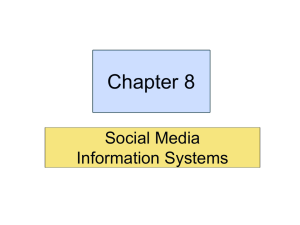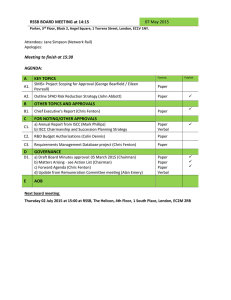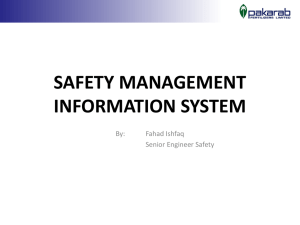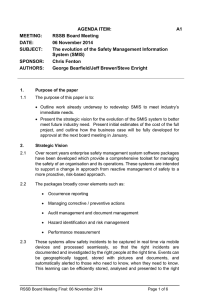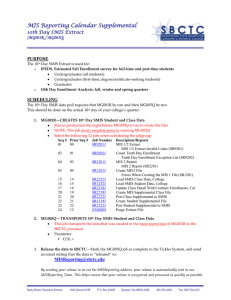Revised SMIS+ implementation plan 4 August 2015
advertisement
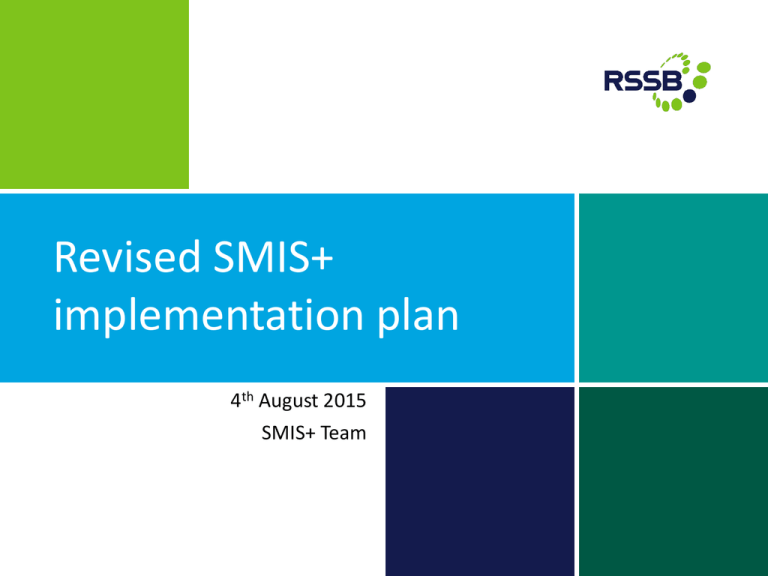
Revised SMIS+ implementation plan 4th August 2015 SMIS+ Team Content • Purpose and rationale • Revised implementation plan • Design & Build Plan (including workstreams) • Design & Build Phases • Deployment Phase • Supplier Deliverables • RSSB Design activities • Questions 2 Revised SMIS+ implementation plan Purpose & Rationale Why are we revising the Implementation Having considered feedback from suppliers and consulted the industry, we have thought it necessary to reconsider our suggested approach on how SMIS+ could be implemented in order to ensure SMIS+ can be delivered on time. Drivers for the change include: 4 • Supplier queries raised on the implementation plan • The need for a realistic internal (RSSB) resourcing plan Revised SMIS+ implementation plan What does this mean at this stage of the programme We have established a revised, suggested implementation plan in order to help suppliers come up with the best plan possible to deliver SMIS+ Therefore we are sharing the revised plan as early as possible in order to: 5 • Allow suppliers to consider the revised plan as part of their bid • Detail, a little more, some of main collaboration areas Revised SMIS+ implementation plan What are the key changes to the revised plan Key changes are: • Breaking the project down into a number of parallel activities, referred to as workstreams • Aligning workstreams to key modules of SMIS+ • Using an iterative approach for the design and build within some of the workstreams • Having a separate workstream for the integration and user testing of SMIS+ However we feel that, the workstreams still needs to be divided up into phases. This is so that: • Clear targets and milestones can still be set between RSSB and the supplier • Review points can be introduced at the end of the phases • Industry still get visibility of how SMIS+ is progressing (after all we are developing this system on behalf of the GB rail industry) 6 Revised SMIS+ implementation plan What does this mean for tenderers By combining the phases, milestones, workstreams and activities the semblance of a new, and hopefully improved, base plan to deliver SMIS+ is now taking shape. We want you to consider the revised, suggested plan as being something that is viable and practical. However, tenderers are actively encouraged to respond with what they consider is their best possible outline implementation plan for SMIS+, along with a justification on how those differ from RSSB’s revised plan. If tenderers' outline implementation plans significantly differ from RSSB's suggested plan, tenderers should be careful to ensure their plan does not significantly impact RSSB's data design plan 7 Revised SMIS+ implementation plan Revised implementation plan Jeff Brewer and Rik Kapoor 8 Revised Implementation Plan RSSB's Proposed SMIS+ Implementation Plan Phase 0: Plan Phase 1: Build of core functionality Phase 2: Expansion of core functionality Plan Phase 3: Expansion of system functionality Phase 4: Completion of system Phase 5: Deployment Deploy Design and Build Milestones: Milestones: Milestones: Milestones: M-7 - Event Managment & Investigation - Sprint 3, 4 and 5 complete M-8 - Analysis/Design of other workstreams in progress / complete M-11 Event Managment & Investigation - Sprint 6, 7 and 8 complete M-15 - Event Managment & Investigation - Sprint 9, 10 and 11 complete M - 16 - Build/Test of other workstreams complete Milestones: Milestones: M-1 - Initiation complete M-2 - Project Plan complete M-3 - Event Managment & Investigation - Sprint 1 and 2 complete M-4 - Analysis/Design of other workstreams in progress M-5 - P1 Integration Testing complete M-6 - P1 User Acceptance Testing complete M-9 - P2 Integration Testing complete M-10 -P2 User Acceptance Testing complete M-12 - Build/Test of other workstreams in progress / complete M-21 - Live Environment(s) ready M-22 - System preparation/population complete M-23 - User Confidence Testing complete M-24 Training material and support documentation complete M-25 - Training to RSSB Support & Development Team complete M - 17 - Specifications complete M-13 - P3 Integration Testing complete M-14 - P3 User Acceptance Testing complete M-26 - Data Migration of SMIS system complete M-27 - Release to SMIS Users M-28 - Data Migration of CCS system M-29 - Release to CCS Users M-18 - P4 Intregration/Regression Testing complete M-19 - P4 User Acceptance/End to End Testing complete M-30 - Warranty Period complete M-31 - Support Contract ready to commence Oct Nov Dec Jan Feb 2015 9 Revised SMIS+ implementation plan Mar Apr May Jun 2016 Jul Aug Sep Oct Nov Dec Jan 2017 Feb Mar Design & Build Plan 10 Design and Build plan O N D J F M A M J J A S O 2015 N D J F 2016 Phase 1 Phase 2 Phase 3 Phase 4 M 2017 Phase 5 1. Event Management & Investigation 2. Reporting & BI SMIS+ Integration and UAT testing SMIS+ deployment Dates TBC 3. Data Management Layer 4. Data Migration 11 Revised SMIS+ implementation plan A M Design and Build plan The design and build plan is built around four main delivery workstreams: 1. Event Management & Investigation processes 2. Reporting & BI 3. Data Management 4. Data Migration In addition there is a further workstream required for integration and testing purposes: SMIS+ Integration & UAT Testing 12 Revised SMIS+ implementation plan 1. Event Management & Investigation workstream Workstream 1 is the configuration and customisation of the system to support the event management and investigation processes. This will also include the administration and maintenance of the processes. This will be based using an iterative design-build-test approach based on a number of sprints. In addition RSSB will perform their own data design activities prior to the commencement of each of the sprints. This will involve consultation with the industry on the SMIS+ data model, including all classifications and definitions. The supplier will be responsible for the sprints and will be supported by RSSB as required. 13 Revised SMIS+ implementation plan 1. Event Management and Investigation workstream RSSB have “nominally” identified 11 sprints, based on 4 weekly cycles: 3 3 4 4 Area of SMIS+ 3 Finish 2 Start Phase 2 Sprint No. 1 1 2 1 23/11/2015 18/12/2015 Event recording for group 1 sub events (complicated) 2 04/01/2016 29/01/2016 Event management for the group 1 sub events 3 01/02/2016 26/02/2016 Setting up hierarchy structure(s) Event recording and managment for group 2+3 sub events (complicated) 4 29/02/2016 25/03/2016 Electronic map functionality (locations/assets) 5 28/03/2016 22/04/2016 Investigation 6 25/04/2016 20/05/2016 Investigation, recommendations, actions and data quality Event recording and managment for group 4,5 and 6 sub events (complicated) 7 23/05/2016 17/06/2016 Causation factors 8 20/06/2016 15/07/2016 Other system functionality - customisations (interfaces, event chain visualisation, etc.) Administration of processes, business rules and forms 9 18/07/2016 12/08/2016 User set up permissions and access permissions Org plus interface (if required) Event recording and managment for group 7 sub events (complicated) 10 15/08/2016 09/09/2016 Testing of data migrated from SMIS and CCS 4 11 12/09/2016 07/10/2016 Final system tidy up and population These are “nominal” sprints to provide an indication on how SMIS+ can be developed in a logical sequence. These will be discussed and confirmed with the supplier prior to commencement of the contract. 14 Revised SMIS+ implementation plan 2. Reporting & BI Workstream 2 is the implementation of the reporting and business intelligence required for SMIS+. This will include the implementation of the data warehouse as well as the creation of reports, charts and dashboards required for the go live of SMIS+ (Phase 5) This will be based on the following approach: • • Strategy on what is required for SMIS+ wrt reporting & BI Design, build, test of the data warehouse, data views and all outputs The development of the strategy will be the responsibility of RSSB but will need to be actively supported by the supplier. After that the supplier will lead the remainder of the reporting & BI workstream with input and support from RSSB throughout. 15 Revised SMIS+ implementation plan 3. Data Management Workstream 3 is the implementation of the data management module required to support SMIS+. This will include the implementation of the data repository, including the integration with external data sources as well as making data available to other modules of SMIS+ for go live (Phase 5) This will be based on the following approach: • • • Design of the data management module, including management processes Design of data flow from interfaces to making data available in SMIS+ Build, integration and test of the data management module The design of the data management module will be a joint activity between RSSB and the supplier. The supplier will lead the data management workstream with input and support from RSSB. 16 Revised SMIS+ implementation plan 4. Data Migration Workstream 4 is the implementation of the data migration from existing systems, SMIS and CCS, into SMIS+. This will involve developing and implementing a solution on how data can be migrated to the new SMIS+ data model. This will be based on the following approach: • • • • • Analysis of the data in the existing systems against the new data model Strategy of how the data will be migrated Design of the migration of data Test of the migration, during the design and build phases Final migration into SMIS+ of existing SMIS and CCS data (deployment activity) The supplier will lead the data migration workstream with input and support from RSSB. The supplier will also be responsible for migrating the data during the deployment phase. 17 Revised SMIS+ implementation plan SMIS+ Integration and UAT testing This will be a parallel workstream running alongside the other delivery workstreams. The benefit of this workstream is to allow for integration and user acceptance testing throughout design and build, enabling any bugs to be fed back into the other design and build activities. This will be based on the following approach: • • • • Development of test strategy and planning between the supplier & RSSB Development of test scenarios, scripts Feeds of data from other workstreams throughout the design & build Execution, review of test results Both RSSB and the supplier will be involved during this workstream, with the supplier responsible for integration testing activities and RSSB responsible for user acceptance testing activities. 18 Revised SMIS+ implementation plan Design and Build Phases 19 Design and Build Phases The Design and Build plan will be split into the following four phases: • Phase 1 - Nov 15 to Jan 16 Aim: Build of core functionality • Phase 2 - Feb 16 to Apr 16 Aim: Expansion of core functionality • Phase 3 – May 16 to Jul 16 Aim: Expansion of overall system functionality • Phase 4 – Aug 16 to Oct 16 Aim: System completion build 20 Revised SMIS+ implementation plan Design and Build Phases Each phase will allow for a review point between RSSB and the supplier. The review will based on ensuring that the design and build is still running on track as well as giving sponsors, stakeholders and other representatives visibility of how the system is progressing. A review of each of the workstreams will be carried out, and where possible, system demonstrations will be performed. Milestone payments will be dependant on successful completion of the review points. RSSB reserve the right to terminate the contract at these review points if the supplier is not delivering according to their contractual obligations and tender. Review points will: • • • • Ensure milestones are being achieved by the supplier Allow for any issues, concerns to be raised across one of more of the workstreams Provide an indication on how well the project is maintaining its timeline Allow for early visibility demonstrations of the system to be given to key stakeholders This will be a joint activity, however the supplier will lead all of the demonstrations and RSSB will be responsible for agreeing whether the review point has been successfully completed 21 Revised SMIS+ implementation plan Deployment Phase 22 Deployment Phase (Phase 5) The deployment will be based on the current deployment phase as described in the SMIS+ High Level Requirements Specification V1.0. This will include: • • • • • Ensuring that the set-up and configuration of SMIS+ is complete Preparing the live environments Supporting industry wide user confidence testing Completion of project documentation Performing the migration from existing systems SMIS and CCs into SMIS+ The supplier will be expected to work in conjunction with the SMIS+ project and business change teams to deliver the application to the end users. The supplier will be responsible for all technical activities for the application. RSSB will make the decision on when SMIS+ will go live and will perform all the necessary business change activities. 23 Revised SMIS+ implementation plan Supplier Deliverables 24 Supplier deliverables Apart from the delivery of the system, the supplier will also be responsible for delivering the following: • Specifications: • • • • • Functional specification, including the data model that will support the system Reporting & BI specification Data Management specification Architecture specification Data Migration specification Because of the nature of the implementation changing to an iterative approach, these documents will be required at the end of the design & build phase. In addition RSSB will be responsible for the Data specification (classifications and definitions) • Training materials: Training materials to RSSB Support and Development Team • Support documentation: As described in the high level requirements specification 25 Revised SMIS+ implementation plan RSSB Data Design activities 26 RSSB Data design activities • RSSB will lead 9 separate data design work streams, whose outputs will feed into the four design and build workstreams. • The approach by RSSB will be iterative, with outputs being fed into specific sprints. Once the sprints commence joint system design and build sessions involving RSSB will be held. • RSSB will be providing considerable resource into these work streams, and work has already commenced. • Part of the RSSB design will also cater for any industry wide consultations that may need to take place. This will be performed by RSSB resources, however input by the supplier to a number of these workstreams may still be required. This will need to be determined once the supplier has commenced the contract. 27 Revised SMIS+ implementation plan Design work streams 1-3 Workstream Aim 1. Sub events • • • • • • • Design the fields and values for the sub-events. Define the terms and associated values. Design any associated risk matrices for sub-events. Review and take into account legal requirements. Identify sub-event workflows. Identify reporting and BI categories, groupings and normalisers. Carry out gap analysis to current reporting models and identify data migration issues. 2. Causation factors • • • Design the fields and values for causation factors. Identify reporting and BI categories, groupings and normalisers. Carry out gap analysis to current reporting models and identify data migration issues. 3. Investigation, recs & actions • Identify the data needs from the investigation, recommendations and actions process and feed them into the safety event data model and the reporting & BI data model. 28 Revised SMIS+ implementation plan Design work streams 4-6 Workstream Aim 4. Data quality • Identify the data needs from the data quality process and feed them into the safety event data model and the reporting & BI data model. 5. Hierarchies • • • • • Identify a definitive list of hierarchies and matrixes required to support the safety event data model. They can take the form of geographical, organisational and functional. Identify the data required for each list. Identify how the lists interact with each other. Identify common locations. Identify how these lists should be used in the data views. • • • Write data specifications for each fixed asset. Identify reporting and BI requirements. Write data governance processes. 6. Fixed assets 29 Revised SMIS+ implementation plan Design work streams 7-9 Workstream Aim 7. Other datasets • 8. Reporting and BI • 9. Migration • • • 30 • • • Analyse current additional system safety datasets and identify which ones to include in SMIS+ and in which format. Identify reporting and BI requirements. Write data governance processes. To have a specification for the data warehouse, the data views and the reports and dashboards required for when SMIS+ is deployed. A reporting and BI data model will be produced showing how data from the data model and the data management layer are combined, grouped, categorised and organised into data views within a data warehouse. Gap analysis of SMIS and Close Call with SMIS+ proposed data model. Identify data migration issues. Write strategy for migrating data from both SMIS and Close Call into SMIS+. Revised SMIS+ implementation plan 1 Sub events 31 Evaluation Revised SMIS+ implementation plan Pre-design (sub event types, conceptual review) Pre design Strategy Deep design - group 1 Evaluation Analysis & evaluation Design Review and design Review and design group 2 Review Specifications Data design group 3 Review Data warehouse Strategy group 4 group 5 A number of the workstream activities shown above align with the build sprints currently identified by RSSB. group 6 2 Causation factors Design 3 Investigation Reporting & BI design 4 Data quality Design 5 Hierarchies Reporting & BI design 6 Data management: asset data Detailed specifications 7 Data management: other data Legacy systems 8 Reporting and BI Design and build reports 9 Data migration Review and design group 7 29 Jul 16 08 Aug 12 Aug 16 01 Aug 05 Aug 16 22 Jul 16 25 Jul 15 Jul 16 11 Jul 18 Jul 08 Jul 16 04 Jul 27 Jun 01 Jul 16 20 Jun 24 Jun 16 13 Jun 17 Jun 16 06 Jun 10 Jun 16 30 May 03 Jun 16 23 May 27 May 16 16 May 20 May 16 09 May 13 May 16 02 May 06 May 16 25 Apr 29 Apr 16 18 Apr 22 Apr 16 11 Apr 15 Apr 16 04 Apr 08 Apr 16 28 Mar 01 Apr 16 21 Mar 25 Mar 16 14 Mar 18 Mar 16 07 Mar 11 Mar 16 29 Feb 04 Mar 16 22 Feb 26 Feb 16 15 Feb 19 Feb 16 08 Feb 12 Feb 16 01 Feb 05 Feb 16 25 Jan 29 Jan 16 18 Jan 22 Jan 16 11 Jan 15 Jan 16 04 Jan 08 Jan 16 28 Dec 01 Jan 16 21 Dec 25 Dec 15 14 Dec 18 Dec 15 07 Dec 11 Dec 15 30 Nov 04 Dec 15 23 Nov 27 Nov 15 16 Nov 20 Nov 15 09 Nov 13 Nov 15 02 Nov 06 Nov 15 26 Oct 30 Oct 15 19 Oct 23 Oct 15 12 Oct 16 Oct 15 05 Oct 09 Oct 15 28 Sep 02 Oct 15 21 Sep 25 Sep 15 14 Sep 18 Sep 15 07 Sep 11 Sep 15 31 Aug 04 Sep 15 24 Aug 28 Aug 15 17 Aug 21 Aug 15 10 Aug 14 Aug 15 03 Aug 07 Aug 15 31 Jul 15 w/c 27 Jul 24 Jul 15 Work stream w/e 20 Jul Design work streams timeline Data design timeline Questions 32
